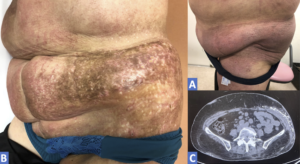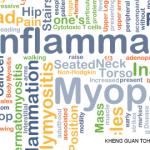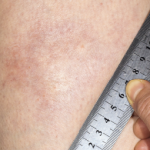Localized Scleroderma in Anti-NXP2-Antibody Positive Dermatomyositis
A 67-year-old woman presented with erythematous, indurated skin on her left flanks. She had been diagnosed with dermatomyositis one year earlier when proximal muscle weakness, dysphagia and skin rash developed (see Figure A). Tests at the time showed the presence of anti-NXP2 and anti-Ro52 antibodies, as well as pathological muscle findings. At that time, systemic glucocorticoids and mycophenolate mofetil alleviated her muscle symptoms, but the skin lesion progressively became hard, like stone, and discolored, with some depigmentation (see Figure B).
A skin biopsy conducted at the time of the current presentation showed vascular dilation and hyperplasia, inflammatory cell infiltrations and degenerated collagen fibers in subcutaneous tissue. A computed tomography scan of her abdomen showed calcinosis cutis (see Figure C). The localized scleroderma was not treated, but the patient is now doing well without worsening localized scleroderma.
Masaki Itagane, MD, is a rheumatologist in the Division of Rheumatology, Department of Internal Medicine at Okinawa Chubu Hospital, Okinawa, Japan.
About the Contest
The Rheumatology Image Library is a highly accessed teaching resource. The 2022 Image Competition sought images representing a diverse range of patients who show either characteristic or unusual manifestations of rheumatic disease, including systemic sclerosis, localized scleroderma and scleroderma mimics. Look for the Best Overall Image on our website and other regional winners in future issues or in the Rheumatology Image Library.




